Study of Microstructural Morphology of Ti-6Al-4V Alloy by Crystallographic Analysis and Phase Field Simulation
Abstract
:1. Introduction
2. Crystallographic Analysis by PTMT
2.1. Transformation Matrix
2.2. Habit Plane between Single Variant and Matrix
2.3. Invariant Plane in Twinned Microstructure
2.4. Orientation Relationship
2.5. Cross-Twin Structure
3. Phase Field Simulation
3.1. Stress-Free Transformation Strain
3.2. Free Energy Formulation
3.3. Kinetic Equation
3.4. Simulation Parameters
4. Simulation Results
4.1. Microstructure Evolution
4.2. Twinned Microstructure
5. Discussion
5.1. The Habit Plane between α Variants and β Matrix
5.2. Crossing Twins
5.3. Triangular Morphology within 3 Variants
6. Summary
- The PTMT is a geometrical (mechanical) theory requiring less time-consuming calculations while the PFM is based on thermodynamic principles; the PFM simulations are computationally more expensive;
- The PTMT is able to calculate the volume fractions of twinned regions and twinning elements, predict the orientation relationship between the parent and product phase, which the PFM in its current implementation is not capable of;
- The PTMT is not able to simulate the microstructural evolution as a function of time, but the PFM has this ability to capture the event of nucleation and growth of α variants and reveal the formation of triangular morphology of variant clusters;
- The special crossing twins observed in other alloys can be predicted geometrically by the PTMT; based on the elastic strain energy minimization with PFMs it was revealed that such special twin configurations are not compatible with the occurrence and/or absence of some variants.
Supplementary Materials
Author Contributions
Funding
Institutional Review Board Statement
Informed Consent Statement
Data Availability Statement
Conflicts of Interest
References
- Donachie, M.J. Titanium: A Technical Guide, 2nd ed.; ASM International: Materials Park, OH, USA, 2000. [Google Scholar]
- Cui, C.; Hu, B.; Zhao, L.; Liu, S. Titanium alloy production technology, market prospects and industry development. Mater. Des. 2011, 32, 1684–1691. [Google Scholar] [CrossRef]
- Xu, W.; Lui, E.W.; Pateras, A.; Qian, M.; Brandt, M.J. In situ tailoring microstructure in additively manufactured Ti-6Al-4V for superior mechanical performance. Acta Mater. 2017, 125, 390–400. [Google Scholar] [CrossRef]
- Dai, N.; Zhang, L.C.; Zhang, J.; Zhang, X.; Ni, Q.; Chen, Y.; Wu, M.; Yang, C. Distinction in corrosion resistance of selective laser melted Ti-6Al-4V alloy on different planes. Corros. Sci. 2016, 111, 703–710. [Google Scholar] [CrossRef] [Green Version]
- Bocchetta, P.; Chen, L.Y.; Tardelli, J.D.C.; Reis, A.C.D.; Almeraya-Calderón, F.; Leo, P. Passive layers and corrosion resistance of biomedical Ti-6Al-4V and β-Ti alloys. Coatings 2021, 11, 487. [Google Scholar] [CrossRef]
- Gong, X.; Cui, Y.; Wei, D.; Liu, B.; Liu, R.; Nie, Y.; Li, Y. Building direction dependence of corrosion resistance property of Ti–6Al–4V alloy fabricated by electron beam melting. Corros. Sci. 2017, 127, 101–109. [Google Scholar] [CrossRef]
- Zheng, Q.; Mao, L.; Shi, Y.; Fu, W.; Hu, Y. Biocompatibility of Ti-6Al-4V titanium alloy implants with laser microgrooved surfaces. Mater. Technol. 2020, 1–10. [Google Scholar] [CrossRef]
- Neto, M.Q.; Radice, S.; Hall, D.J.; Frisch, N.B.; Mathew, M.T.; Fischer, A.; Jacobs, J.J.; Pourzal, R. Microstructure and electrochemical behavior of contemporary Ti6Al4V implant alloys. J. Bio.-Tribo.-Corro. 2022, 8, 1–17. [Google Scholar] [CrossRef] [PubMed]
- Shah, F.A.; Snis, A.; Matic, A.; Thomsen, P.; Palmquist, A. 3D printed Ti6Al4V implant surface promotes bone maturation and retains a higher density of less aged osteocytes at the bone-implant interface. Acta Biomater. 2016, 30, 357–367. [Google Scholar] [CrossRef]
- Yang, X.S.; Sun, S.; Wu, X.L.; Ma, E.; Zhang, T.Y. Dissecting the mechanism of martensitic transformation via atomic-scale observations. Sci. Rep. 2014, 4, 6141. [Google Scholar] [CrossRef] [Green Version]
- Liu, J.; Chen, C.; Feng, Q.; Fang, X.; Wang, H.; Liu, F.; Lu, J.; Raabe, D. Dislocation activities at the martensite phase transformation interface in metastable austenitic stainless steel: An in-situ TEM study. Mater. Sci. Eng. A 2017, 703, 236–243. [Google Scholar] [CrossRef] [Green Version]
- Bhattacharya, K. Microstructure of Martensite: Why It Forms and How It Gives Rise to the Shape-Memory Effect; Oxford University Press: Oxford, UK, 2003; Volume 2. [Google Scholar]
- Cayron, C. Complements to Mügge and Friedel’s theory of twinning. Metals 2020, 10, 231. [Google Scholar] [CrossRef] [Green Version]
- Nishida, M.; Matsuda, M.; Yasumoto, Y.; Yano, S.; Yamabe-Mitarai, Y.; Hara, T. Crystallography and morphology of twins in equiatomic TiPt martensite. Mater. Sci. Technol. 2008, 24, 884–889. [Google Scholar] [CrossRef]
- Kovarik, L.; Yang, F.; Garg, A.; Diercks, D.; Kaufman, M.; Noebe, R.D.; Mills, M.J. Structural analysis of a new precipitate phase in high-temperature TiNiPt shape memory alloys. Acta Mater. 2010, 58, 4660–4673. [Google Scholar] [CrossRef]
- Gao, Y.; Zhou, N.; Wang, D.; Wang, Y. Pattern formation during cubic to orthorhombic martensitic transformations in shape memory alloys. Acta Mater. 2014, 68, 93–105. [Google Scholar] [CrossRef]
- Zhu, J.; Wu, H.; Wang, D.; Gao, Y.; Wang, H.; Hao, Y.; Yang, R.; Zhang, T.Y.; Wang, Y. Crystallographic analysis and phase field simulation of transformation plasticity in a multifunctional β-Ti alloy. Int. J. Plast. 2017, 89, 110–129. [Google Scholar] [CrossRef] [Green Version]
- Ma, Y.; Xue, Q.; Wang, H.; Huang, S.; Qiu, J.; Feng, X.; Lei, J.; Yang, R. Deformation twinning in fatigue crack tip plastic zone of Ti-6Al-4V alloy with Widmanstatten microstructure. Mater. Charact. 2017, 132, 338–347. [Google Scholar] [CrossRef]
- Zheng, X.; Zheng, S.; Wang, J.; Ma, Y.; Wang, H.; Zhou, Y.; Shao, X.; Zhang, B.; Lei, J.; Yang, R.; et al. Twinning and sequential kinking in lamellar Ti-6Al-4V alloy. Acta Mater. 2019, 181, 479–490. [Google Scholar] [CrossRef]
- Wang, H.; Chao, Q.; Yang, L.; Cabral, M.; Song, Z.Z.; Wang, B.Y.; Primig, S.; Xu, W.; Chen, Z.B.; Ringer, S.P.; et al. Introducing transformation twins in titanium alloys: An evolution of α-variants during additive manufacturing. Mater. Res. Lett. 2021, 9, 119–126. [Google Scholar] [CrossRef]
- Farabi, E.; Tari, V.; Hodgson, P.D. On the grain boundary network characteristics in a martensitic Ti–6Al–4V alloy. J. Mater. Sci. 2020, 55, 15299–15321. [Google Scholar] [CrossRef]
- Greninger, A.B.; Troiano, A.R. Crystallography of austenite decomposition. Trans. AIME 1940, 140, 307–336. [Google Scholar]
- Lieberman, D.S. Martensitic transformations and determination of the inhomogeneous deformation. Acta Met. 1958, 6, 680–693. [Google Scholar] [CrossRef]
- Olson, G.; Lieberman, D.; Saxena, A. (Eds.) International Conference on Martensitic Transformations (ICOMAT) 2008; John Wiley & Sons: Hoboken, NJ, USA, 2013. [Google Scholar]
- Bowles, J.S.; Mackenzie, J.K. The crystallography of martensite transformations I. Acta Met. 1954, 2, 129–137. [Google Scholar] [CrossRef]
- Mackenzie, J.K.; Bowles, U.J. The crystallography of martensite transformations II. Acta Met. 1954, 2, 138–147. [Google Scholar] [CrossRef]
- Lieberman, D.S.; Wechsler, M.S.; Read, T.A. Cubic to orthorhombic diffusionless phase change—experimental and theoretical studies of AuCd. Int. J. Appl. Phys. 1955, 26, 473–484. [Google Scholar] [CrossRef]
- Sun, B.; Meng, X.; Gao, Z.; Cai, W. Crystallography Study on the Internal Twinning of Ti–Nb-Based Shape Memory Alloys. Cryst. Res. Technol. 2018, 53, 1800067. [Google Scholar] [CrossRef]
- Pond, R.C.; Celotto, S.; Hirth, J.P. A comparison of the phenomenological theory of martensitic transformations with a model based on interfacial defects. Acta. Mater. 2003, 51, 5385–5398. [Google Scholar] [CrossRef]
- Qiu, D.; Zhang, W.Z. A TEM study of the crystallography of austenite precipitates in a duplex stainless steel. Acta. Mater. 2007, 55, 6754–6764. [Google Scholar] [CrossRef]
- Ackerman, A.K.; Vorontsov, V.A.; Bantounas, I.; Zheng, Y.; Chang, Y.; McAuliffe, T.; Clark, W.A.; Fraser, H.L.; Gault, B.; Rugg, D.; et al. Interface characteristics in an α+ β titanium alloy. Phys. Rev. Mater. 2020, 4, 013602. [Google Scholar] [CrossRef] [Green Version]
- Gundyrev, V.M.; Zel’dovich, V.I. Crystallographic analysis of the FCC→ BCC martensitic transformation in high-carbon steel. Phys. Metals Metallogr. 2014, 115, 973–980. [Google Scholar] [CrossRef]
- De Knijf, D.; Nguyen-Minh, T.; Petrov, R.H.; Kestens, L.A.I.; Jonas, J.J. Orientation dependence of the martensite transformation in a quenched and partitioned steel subjected to uniaxial tension. J. Appl. Crystallogr. 2014, 47, 1261–1266. [Google Scholar] [CrossRef]
- Graf, M.; Kuntz, M.; Autenrieth, H.; Diewald, F.; Müller, R. Simulation of martensitic microstructures in a low-alloy steel. Arch. Appl. Mech. 2021, 91, 1641–1668. [Google Scholar] [CrossRef]
- Farabi, E.; Hodgson, P.D.; Rohrer, G.S.; Beladi, H. Five-parameter intervariant boundary characterization of martensite in commercially pure titanium. Acta Mater. 2018, 154, 147–160. [Google Scholar] [CrossRef]
- Bignon, M.; Bertrand, E.; Rivera-Díaz-Del-Castillo, P.E.; Tancret, F. Martensite formation in titanium alloys: Crystallographic and compositional effects. J. Alloys Compd. 2021, 872, 159636. [Google Scholar] [CrossRef]
- Cahn, J.W. On spinodal decomposition. Acta Met. 1961, 9, 795–801. [Google Scholar] [CrossRef]
- Allen, S.M.; Cahn, J.W. Ground state structures in ordered binary alloys with second neighbor interactions. Acta Met. 1972, 20, 423–433. [Google Scholar] [CrossRef]
- Khachaturyan, A.G. Theory of Structural Transformations in Solids; John Wiley & Sons: New York, NY, USA, 1983. [Google Scholar]
- Wang, Y.; Khachaturyan, A.G. Three-dimensional field model and computer modeling of martensitic transformations. Acta Mater. 1997, 45, 759–773. [Google Scholar] [CrossRef]
- Boettinger, W.J.; Warren, J.A.; Beckermann, C.; Karma, A. Phase-field simulation of solidification. Annu. Rev. Mater. Res. 2002, 32, 163–194. [Google Scholar] [CrossRef]
- Chen, L.Q. Phase-field models for microstructure evolution. Annu. Rev. Mater. Res. 2002, 32, 113–140. [Google Scholar] [CrossRef] [Green Version]
- Zhang, J.X.; Li, Y.L.; Schlom, D.G.; Chen, L.Q.; Zavaliche, F.; Ramesh, R.; Jia, Q.X. Phase-field model for epitaxial ferroelectric and magnetic nanocomposite thin films. Appl. Phys. Lett. 2007, 90, 052909. [Google Scholar] [CrossRef] [Green Version]
- Li, L.J.; Li, J.Y.; Shu, Y.C.; Chen, H.Z.; Yen, J.H. Magnetoelastic domains and magnetic field-induced strains in ferromagnetic shape memory alloys by phase-field simulation. Appl. Phys. Lett. 2008, 92, 172504. [Google Scholar] [CrossRef]
- Zeng, Y.; Mittnacht, T.; Werner, W.; Du, Y.; Schneider, D.; Nestler, B. Gibbs energy and phase-field modeling of ferromagnetic ferrite (α)→ paramagnetic austenite (γ) transformation in Fe–C alloys under an external magnetic field. Acta Mater. 2022, 225, 117595. [Google Scholar] [CrossRef]
- Shi, R.; Ma, N.; Wang, Y. Predicting equilibrium shape of precipitates as function of coherency state. Acta Mater. 2012, 60, 4172–4184. [Google Scholar] [CrossRef]
- Shi, R.; Wang, Y. Variant selection during α precipitation in Ti–6Al–4V under the influence of local stress–A simulation study. Acta Mater. 2013, 61, 6006–6024. [Google Scholar] [CrossRef]
- Qiu, D.; Zhao, P.; Shi, R.; Wang, Y.; Lu, W. Effect of autocatalysis on variant selection of α precipitates during phase transformation in Ti-6Al-4V alloy. Comput. Mater. Sci. 2016, 124, 282–289. [Google Scholar] [CrossRef] [Green Version]
- Qiu, D.; Shi, R.; Zhao, P.; Zhang, D.; Lu, W.; Wang, Y. Effect of low-angle grain boundaries on morphology and variant selection of grain boundary allotriomorphs and Widmanstätten side-plates. Acta Mater. 2016, 112, 347–360. [Google Scholar] [CrossRef] [Green Version]
- Burgers, W.G. On the process of transition of the cubic-body-centered modification into the hexagonal-close-packed modification of zirconium. Physica 1934, 1, 561–586. [Google Scholar] [CrossRef]
- Wang, S.C.; Aindow, M.; Starink, M.J. Effect of self-accommodation on α/α boundary populations in pure titanium. Acta Mater. 2003, 51, 2485–2503. [Google Scholar] [CrossRef]
- Ojha, A.; Sehitoglu, H. Critical stress for the bcc–hcp martensite nucleation in Ti–6.25 at.% Ta and Ti–6.25 at.% Nb alloys. Comput. Mater. Sci. 2016, 111, 157–162. [Google Scholar] [CrossRef]
- Chen, P.; Wang, F.; Li, B. Transitory phase transformations during {10-12} twinning in titanium. Acta Mater. 2019, 171, 65–78. [Google Scholar] [CrossRef]
- Cayron, C. Continuous atomic displacements and lattice distortion during fcc–bcc martensitic transformation. Acta Mater. 2015, 96, 189–202. [Google Scholar] [CrossRef] [Green Version]
- Ball, J.M.; James, R.D. Proposed experimental tests of a theory of fine microstructure and the two-well problem. Philos. Trans. Phys. Sci. Eng. 1992, 338, 389–450. [Google Scholar] [CrossRef]
- Hane, K.F.; Shield, T.W. Microstructure in the cubic to monoclinic transition in titanium–nickel shape memory alloys. Acta Mater. 1999, 47, 2603–2617. [Google Scholar] [CrossRef]
- Srivastava, D.; Madangopal, K.; Banerjee, S.; Ranganathan, S. Self accomodation morphology of martensite variants in Zr- 2.5 wt% Nb alloy. Acta Met. 1993, 41, 3445–3454. [Google Scholar] [CrossRef]
- Banerjee, S.; Mukhopadhyay, P. Phase Transformations: Examples from Titanium and Zirconium Alloys; Elsevier: Amsterdam, The Netherlands, 2010. [Google Scholar]
- Cao, S.; Zou, Y.; Lim, C.V.S.; Wu, X. Review of laser powder bed fusion (LPBF) fabricated Ti-6Al-4V: Process, post-process treatment, microstructure, and property. Light Adv. Manuf. 2021, 2, 313–332. [Google Scholar] [CrossRef]
- He, J.; Li, D.; Jiang, W.; Ke, L.; Qin, G.; Ye, Y.; Qin, Q.; Qiu, D. The martensitic transformation and mechanical properties of Ti6Al4V prepared via selective laser melting. Materials 2019, 12, 321. [Google Scholar] [CrossRef] [Green Version]
- Cao, S.; Chu, R.; Zhou, X.; Yang, K.; Jia, Q.; Lim, C.V.S.; Huang, A.; Wu, X. Role of martensite decomposition in tensile properties of selective laser melted Ti-6Al-4V. J. Alloy. Compd. 2018, 744, 357–363. [Google Scholar] [CrossRef]
- Yeddu, H.K.; Malik, A.; Ågren, J.; Amberg, G.; Borgenstam, A. Three-dimensional phase-field modeling of martensitic microstructure evolution in steels. Acta Mater. 2012, 60, 1538–1547. [Google Scholar] [CrossRef]
- Perrin, J. Mouvement brownien et réalité moléculaire. 1909. Available online: https://djalil.chafai.net/docs/M2/history-brownian-motion/Perrin%20-%201909%20-%20French.pdf (accessed on 29 July 2022).
- Petschek, R.G.; Metiu, H. A computer simulation of the time-dependent Ginzburg–Landau model for spinodal decomposition. J. Chem. Phys. 1983, 79, 3443–3456. [Google Scholar] [CrossRef]
- Rogers, T.M.; Elder, K.R.; Desai, R.C. Numerical study of the late stages of spinodal decomposition. Phys. Rev. B 1988, 37, 9638. [Google Scholar] [CrossRef]
- Chen, Q.; Ma, N.; Wu, K.; Wang, Y. Quantitative phase field modeling of diffusion-controlled precipitate growth and dissolution in Ti–Al–V. Scr. Mater. 2004, 50, 471–476. [Google Scholar] [CrossRef]
- Lindwall, G.; Moon, K.W.; Chen, Z.; Mengason, M.; Williams, M.E.; Gorham, J.M.; Zhao, J.C.; Campbell, C.E. Diffusion in the Ti-Al-V system. J. Phase Equilibria Diffus. 2018, 39, 731–746. [Google Scholar] [CrossRef] [Green Version]
- Chen, L.Q.; Shen, J. Applications of semi-implicit Fourier-spectral method to phase field equations. Comput. Phys. Commun. 1998, 108, 147–158. [Google Scholar] [CrossRef]
- Xiang, H.; Van Paepegem, W.; Kestens, L.A.I. Variant selection during BCC to HCP Phase Transformation in Selective Laser Melted Ti-6Al-4V. Materialia 2022, 24, 101470. [Google Scholar] [CrossRef]
- Waitz, T.; Antretter, T.; Fischer, F.D.; Karnthaler, H.P. Size effects on martensitic phase transformations in nanocrystalline NiTi shape memory alloys. Mater. Sci. Technol. 2008, 24, 934–940. [Google Scholar] [CrossRef]
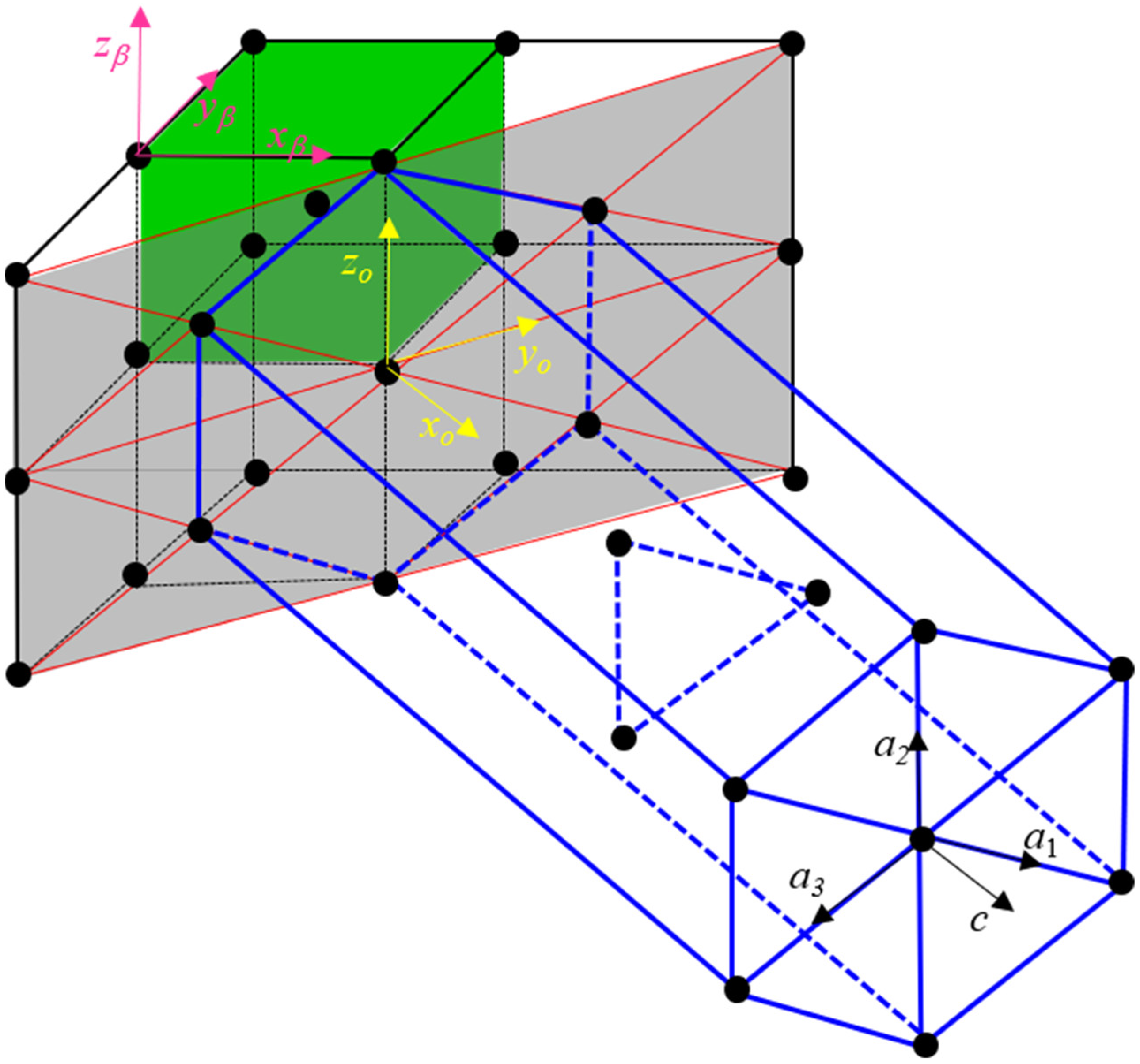
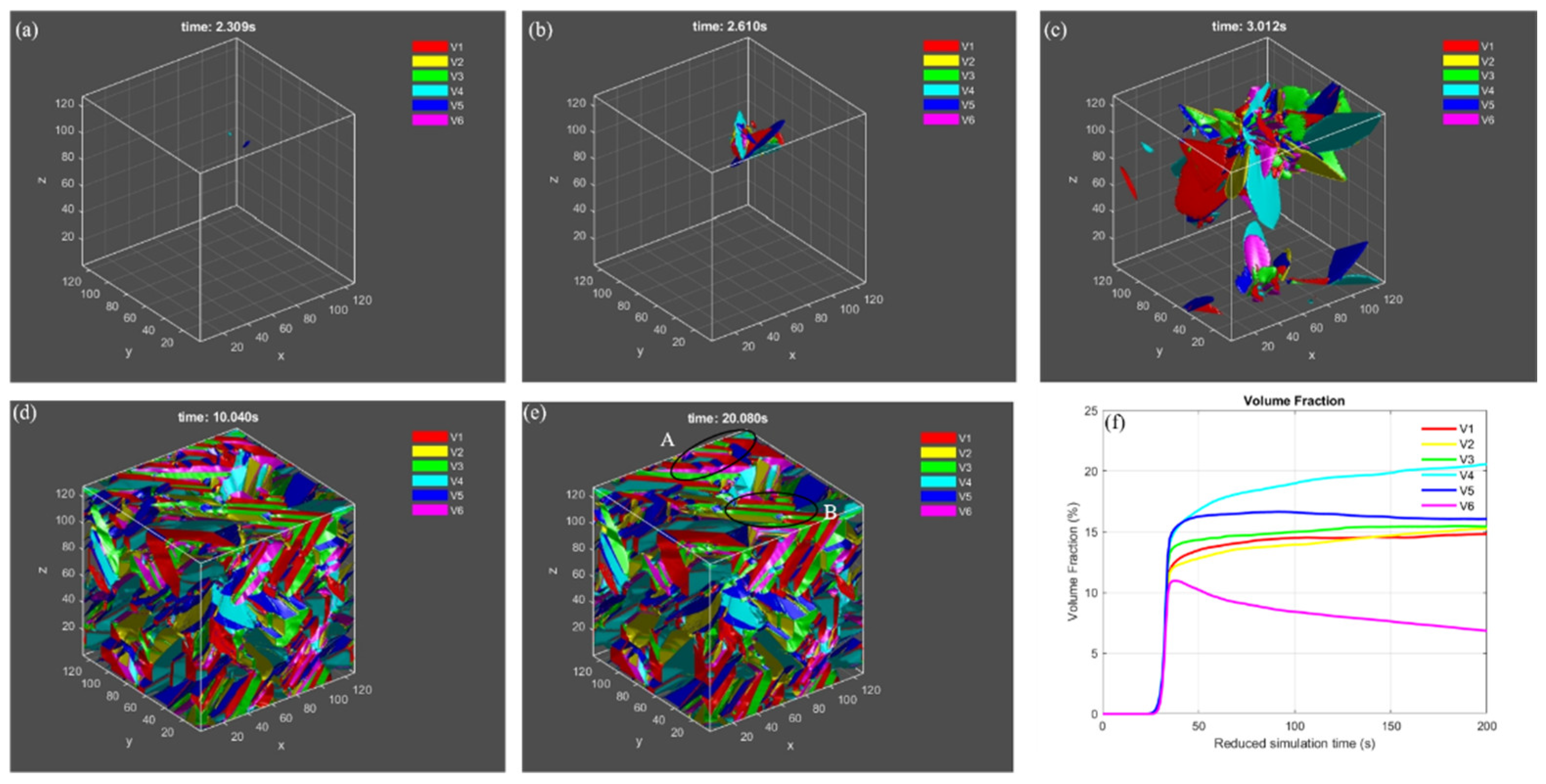
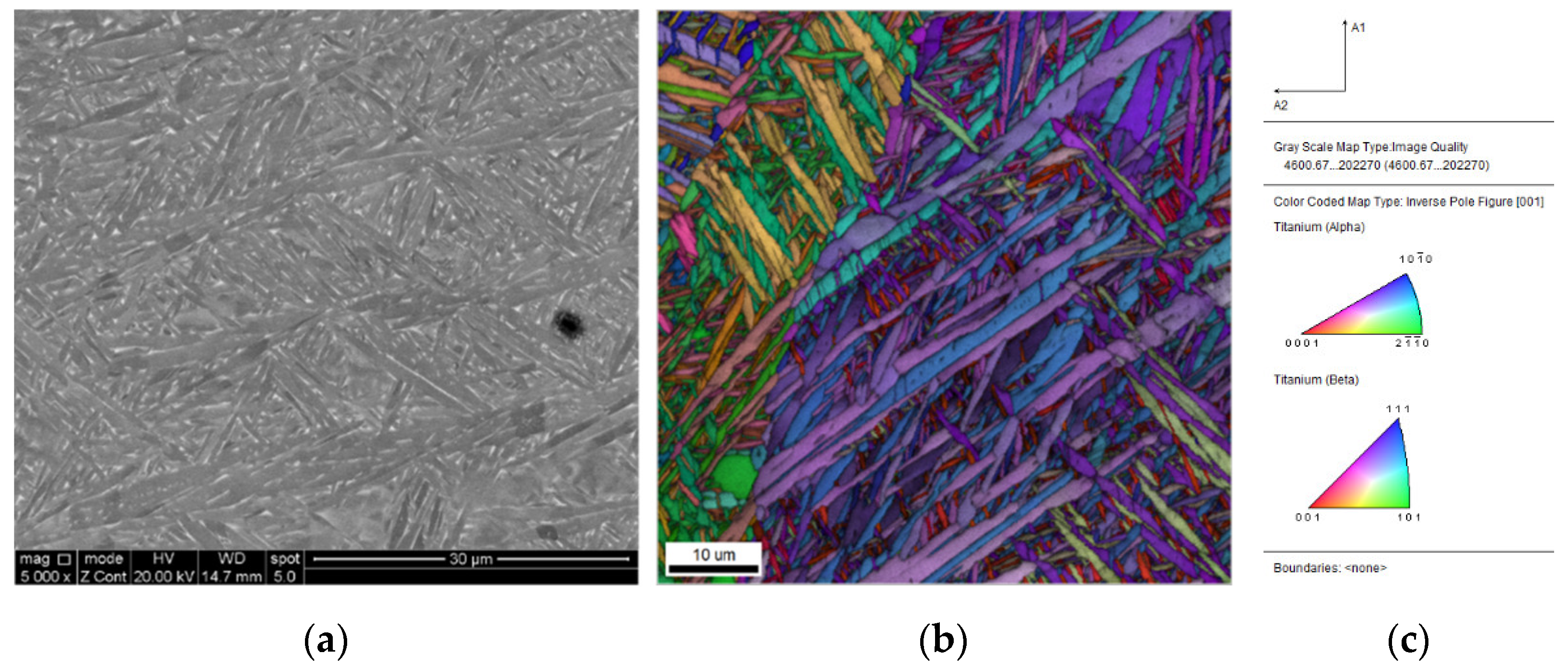

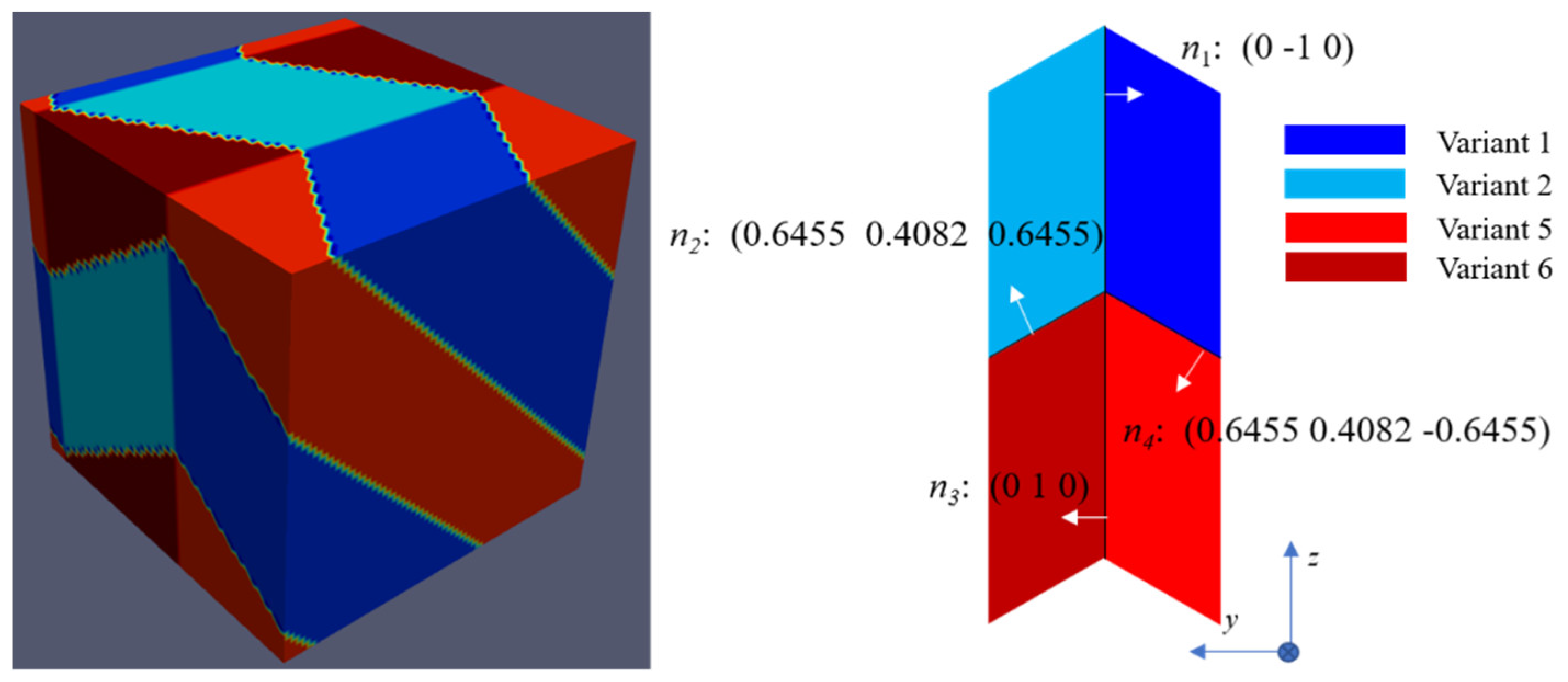
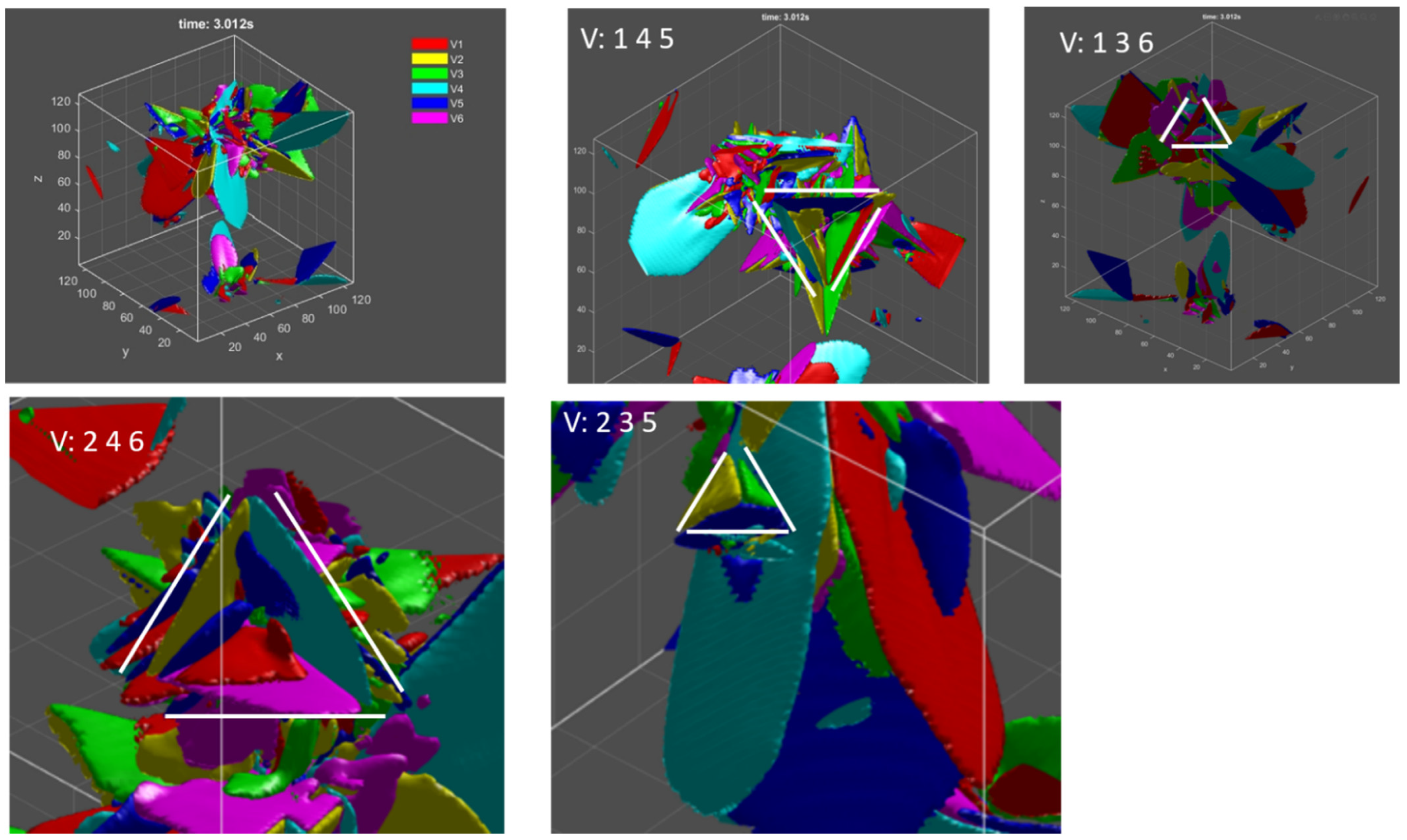
| Variant | Shear Vector b | Habit Plane Normal m |
|---|---|---|
| 1 | (0.1567 −0.0885 0.0885) | (−0.7147 −0.4946 0.4946) |
| (0.1567 0.0885 −0.0885) | (−0.7147 0.4946 −0.4946) | |
| 2 | (0.1567 0.0885 0.0885) | (−0.7147 0.4946 0.4946) |
| (0.1567 −0.0885 −0.0885) | (−0.7147 −0.4946 −0.4946) | |
| 3 | (−0.0885 0.1567 0.0885) | (−0.4946 −0.7147 0.4946) |
| (0.0885 0.1567 −0.0885) | (0.4946 −0.7147 −0.4946) | |
| 4 | (0.0885 −0.1567 0.0885) | (0.4946 0.7147 0.4946) |
| (−0.0885 −0.1567 −0.0885) | (−0.4946 0.7147 −0.4946) | |
| 5 | (−0.0885 0.0885 0.1567) | (−0.4946 0.4946 −0.7147) |
| (0.0885 −0.0885 0.1567) | (0.4946 −0.4946 −0.7147) | |
| 6 | (0.0885 0.0885 0.1567) | (0.4946 0.4946 −0.7147) |
| (−0.0885 −0.0885 0.1567) | (−0.4946 −0.4946 −0.7147) |
| Compound | Twin Shear a | Twin Plane Normal n |
|---|---|---|
| Variant: 1/2 | (0 −0.1824 −0.008) | (0 0 1) |
| (0 −0.008 −0.1824) | (0 1 0) | |
| Variant: 3/4 | (−0.1824 0 −0.008) | (0 0 1) |
| (−0.008 0 −0.1824) | (1 0 0) | |
| Variant: 5/6 | (−0.1824 −0.008 0) | (0 1 0) |
| (−0.008 −0.1824 0) | (1 0 0) |
| Type I | Twin Shear a | Twin Plane Normal n |
|---|---|---|
| Variant:1/3 | (−0.2357 −0.1968 0.1189) | (1 −1 0) |
| Variant:1/4 | (−0.2357 0.1968 −0.1189) | (1 1 0) |
| Variant:1/5 | (−0.2357 0.1189 −0.1968) | (1 0 −1) |
| Variant:1/6 | (−0.2357 −0.1189 0.1968) | (1 0 1) |
| Variant:2/3 | (−0.2357 0.1968 0.1189) | (1 1 0) |
| Variant:2/4 | (−0.2357 −0.1968 −0.1189) | (1 −1 0) |
| Variant:2/5 | (−0.2357 0.1189 0.1968) | (1 0 1) |
| Variant:2/6 | (−0.2357 −0.1189 −0.1968) | (1 0 −1) |
| Variant:3/5 | (−0.1189 0.2357 0.1968) | (0 −1 1) |
| Variant:3/6 | (−0.1189 −0.2357 0.1968) | (0 1 1) |
| Variant:4/5 | (0.1189 −0.2357 0.1968) | (0 1 1) |
| Variant:4/6 | (0.1189 0.2357 0.1968) | (0 −1 1) |
| Type II | Twin Shear a | Twin Plane Normal n |
|---|---|---|
| Variant:1/3 | (−0.2590 0.2207 0.0113) | (0.6455 0.6455 −0.4082) |
| Variant:1/4 | (−0.2590 −0.2207 −0.0113) | (0.6455 −0.6455 0.4082) |
| Variant:1/5 | (−0.2590 0.0113 0.2207) | (0.6455 −0.4082 0.6455) |
| Variant:1/6 | (−0.2590 −0.0113 −0.2207) | (0.6455 0.4082 −0.6455) |
| Variant:2/3 | (−0.2590 −0.2207 0.0113) | (0.6455 −0.6455 −0.4082) |
| Variant:2/4 | (−0.2590 0.2207 −0.0113) | (0.6455 0.6455 0.4082) |
| Variant:2/5 | (−0.2590 0.0113 −0.2207) | (0.6455 −0.4082 −0.6455) |
| Variant:2/6 | (−0.2590 −0.0113 0.2207) | (0.6455 0.4082 0.6455) |
| Variant:3/5 | (−0.0113 0.2590 −0.2207) | (0.4082 −0.6455 −0.6455) |
| Variant:3/6 | (−0.0113 −0.2590 −0.2207) | (0.4082 0.6455 −0.6455) |
| Variant:4/5 | (0.0113 −0.2590 −0.2207) | (−0.4082 0.6455 −0.6455) |
| Variant:4/6 | (0.0113 0.2590 −0.2207) | (−0.4082 −0.6455 −0.6455) |
| Variants: 2/5 | Habit Plane Normal m | Angular Deviation (°) from {3 3 4} | |
|---|---|---|---|
| Type I | 0.0398 | (0.4720 −0.5039 −0.7233) | 3.2961 |
| 0.0398 | (−0.4771 0.5210 −0.7078) | 2.5103 | |
| 0.9602 | (−0.7233 0.5039 0.4720) | 3.2961 | |
| 0.9602 | (−0.7078 −0.5210 −0.4771) | 2.5103 | |
| Type II | 0.0539 | (0.4720 −0.5039 −0.7233) | 3.8003 |
| 0.0539 | (−0.4771 0.5210 −0.7078) | 2.8937 | |
| 0.9461 | (−0.7233 0.5039 0.4720) | 2.8937 | |
| 0.9461 | (−0.7078 −0.5210 −0.4771) | 3.8003 |
| Variant | Predicted (0 0 0 1) Plane | Direction | |
|---|---|---|---|
| 1 | 5.1311° | 0.0715° | |
| 2 | 5.1311° | 0.0715° | |
| 3 | 4.6233° | 5.4979° | |
| 4 | 5.7329° | 0.0715° | 0.9657° |
| 5 | |||
| 6 |
| Physical Parameters | Symbol | Value | Unit |
|---|---|---|---|
| Temperature | T | 1073 | K |
| Grid size | 25 | nm | |
| System size | 128, 128, 128 | - | |
| Interface thickness | nm | ||
| Interfacial energy | |||
| Molar volume | |||
| Kinetic coefficient | |||
| Elastic constant | 97.7, 82.7, 7.5 | GPa | |
| Time step | dt | s | |
| Normalization factor |
| Variant | Angular Deviation(°) from {3 3 4} | ||
|---|---|---|---|
| 1 | (0.7122 −0.4972 0.4955) | 1.70 × 105 | 2.10 |
| 2 | (0.7122 −0.4972 −0.4955) | 1.70 × 105 | 2.10 |
| 3 | (−0.4972 0.7122 0.4955) | 1.70 × 105 | 2.10 |
| 4 | (−0.4972 0.7122 −0.4955) | 1.70 × 105 | 2.10 |
| 5 | (−0.4968 0.4968 0.7115) | 1.75 × 105 | 2.04 |
| 6 | (0.4968 0.4968 0.7115) | 1.75 × 105 | 2.04 |
| Variant | Angular Deviation (°) from {3 3 4} | ||
|---|---|---|---|
| 1/2 | (−0.7141 0.4919 0.4982) | 1.65 × 106 | 2.27 |
| 1/3 | (0.4811 0.7176 −0.5036) | 2.13 × 104 | 2.71 |
| 1/4 | (0.4811 −0.7176 0.5036) | 2.13 × 104 | 2.71 |
| 1/5 | (−0.4742 0.5245 0.7071) | 2.10 × 104 | 2.71 |
| 1/6 | (0.4742 0.5245 0.7071) | 2.10 × 104 | 2.71 |
Publisher’s Note: MDPI stays neutral with regard to jurisdictional claims in published maps and institutional affiliations. |
© 2022 by the authors. Licensee MDPI, Basel, Switzerland. This article is an open access article distributed under the terms and conditions of the Creative Commons Attribution (CC BY) license (https://creativecommons.org/licenses/by/4.0/).
Share and Cite
Xiang, H.; Van Paepegem, W.; Kestens, L.A.I. Study of Microstructural Morphology of Ti-6Al-4V Alloy by Crystallographic Analysis and Phase Field Simulation. Materials 2022, 15, 5325. https://doi.org/10.3390/ma15155325
Xiang H, Van Paepegem W, Kestens LAI. Study of Microstructural Morphology of Ti-6Al-4V Alloy by Crystallographic Analysis and Phase Field Simulation. Materials. 2022; 15(15):5325. https://doi.org/10.3390/ma15155325
Chicago/Turabian StyleXiang, Hao, Wim Van Paepegem, and Leo A. I. Kestens. 2022. "Study of Microstructural Morphology of Ti-6Al-4V Alloy by Crystallographic Analysis and Phase Field Simulation" Materials 15, no. 15: 5325. https://doi.org/10.3390/ma15155325
APA StyleXiang, H., Van Paepegem, W., & Kestens, L. A. I. (2022). Study of Microstructural Morphology of Ti-6Al-4V Alloy by Crystallographic Analysis and Phase Field Simulation. Materials, 15(15), 5325. https://doi.org/10.3390/ma15155325






